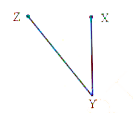A diagonal of a parallelogram bisects an angle. Will it also bisect the other angle? Give reason.
To determine whether a diagonal of a parallelogram that bisects one angle also bisects the other angle, we can follow these steps:
1. Draw the Parallelogram:
Let's denote the parallelogram as ABCD. Draw the parallelogram with vertices A, B, C, and D.
2. Draw the Diagonal:
Draw the diagonal AC. This diagonal will be the line segment connecting vertices A and C.
3. Identify the Angles:
Let angle D be bisected by the diagonal AC. This means that angle D is split into two equal angles, which we will call angle 1 and angle 2. Thus, we have:
- Angle 1 = Angle 2 (since AC bisects angle D).
4. Use Properties of Parallelograms:
In a parallelogram, opposite sides are parallel. Therefore, we have:
- AB || CD (AB is parallel to CD).
- AD || BC (AD is parallel to BC).
5. Apply Alternate Angle Theorem:
Since AB is parallel to CD, and AC is a transversal line, we can apply the Alternate Angle Theorem:
- Angle 1 (∠DAB) is equal to angle 4 (∠BCD).
- Angle 2 (∠ADC) is equal to angle 3 (∠ABC).
6. Establish Relationships:
From the relationships established:
- Angle 1 = Angle 4
- Angle 2 = Angle 3
- And since Angle 1 = Angle 2 (from the bisection), we can conclude:
- Angle 3 = Angle 4.
7. Conclusion:
Since angle 3 (∠ABC) is equal to angle 4 (∠BCD), we can conclude that if a diagonal of a parallelogram bisects one angle, it will also bisect the opposite angle.
Final Statement:
Thus, the answer to the question is: Yes, if a diagonal of a parallelogram bisects one angle, it will also bisect the other angle due to the properties of parallel lines and alternate angles.
---
Let's denote the parallelogram as ABCD. Draw the parallelogram with vertices A, B, C, and D.
Draw the diagonal AC. This diagonal will be the line segment connecting vertices A and C.
Let angle D be bisected by the diagonal AC. This means that angle D is split into two equal angles, which we will call angle 1 and angle 2. Thus, we have:
- Angle 1 = Angle 2 (since AC bisects angle D).
In a parallelogram, opposite sides are parallel. Therefore, we have:
- AB || CD (AB is parallel to CD).
- AD || BC (AD is parallel to BC).
Since AB is parallel to CD, and AC is a transversal line, we can apply the Alternate Angle Theorem:
- Angle 1 (∠DAB) is equal to angle 4 (∠BCD).
- Angle 2 (∠ADC) is equal to angle 3 (∠ABC).
From the relationships established:
- Angle 1 = Angle 4
- Angle 2 = Angle 3
- And since Angle 1 = Angle 2 (from the bisection), we can conclude:
- Angle 3 = Angle 4.
Since angle 3 (∠ABC) is equal to angle 4 (∠BCD), we can conclude that if a diagonal of a parallelogram bisects one angle, it will also bisect the opposite angle.
Thus, the answer to the question is: Yes, if a diagonal of a parallelogram bisects one angle, it will also bisect the other angle due to the properties of parallel lines and alternate angles.
Topper's Solved these Questions
- UNDERSTANDING QUADRILATERALS AND PRACTICAL GEOMETRYBOOK - NCERT EXEMPLARCHAPTER - UNDERSTANDING QUADRILATERALS AND PRACTICAL GEOMETRYEXERCISE - APPLICATIONS, GAMES AND PUZZLES
3 Videos
- UNDERSTANDING QUADRILATERALS AND PRACTICAL GEOMETRYBOOK - NCERT EXEMPLARCHAPTER - UNDERSTANDING QUADRILATERALS AND PRACTICAL GEOMETRYEXERCISE - THINK AND DISCUSS
2 Videos
- UNDERSTANDING QUADRILATERALS AND PRACTICAL GEOMETRYBOOK - NCERT EXEMPLARCHAPTER - UNDERSTANDING QUADRILATERALS AND PRACTICAL GEOMETRYEXERCISE - THINK AND DISCUSS
2 Videos
- SQUARE - SQUARE ROOT AND CUBE-CUBE ROOTBOOK - NCERT EXEMPLARCHAPTER - SQUARE - SQUARE ROOT AND CUBE-CUBE ROOTEXERCISE - Exercise
52 Videos
- VISUALISING SOLID SHAPES BOOK - NCERT EXEMPLARCHAPTER - VISUALISING SOLID SHAPES EXERCISE - EXERCISE
91 Videos
Similar Questions
The diagonals of a parallelogram bisect each other.
View SolutionThe diagonals of a parallelogram bisect each other.
View SolutionBisect ∠XYZ

View SolutionIn a diagonal of a parallelogram bisects one of the angles of the parallelogram; it also bisects the second angle.
View SolutionIf diagonal of a parallelogram bisects one of the angles of the parallelogram, it also bisects the second angle. Also, prove that it is a rhombus.
View SolutionThe diagonals of parallelogram bisect each other ( True/ False)
View Solutionif diagonals of a parallelogram bisect each other,prove that its a rhombus
View SolutionThe diagonals of a ||gm bisect each other
View SolutionIf diagonal of a quadrilateral bisects each other at right angles then it is a
View SolutionIf one diagonal of a quadrilateral bisects the other, then it also bisects the quadrilateral.
View Solution
